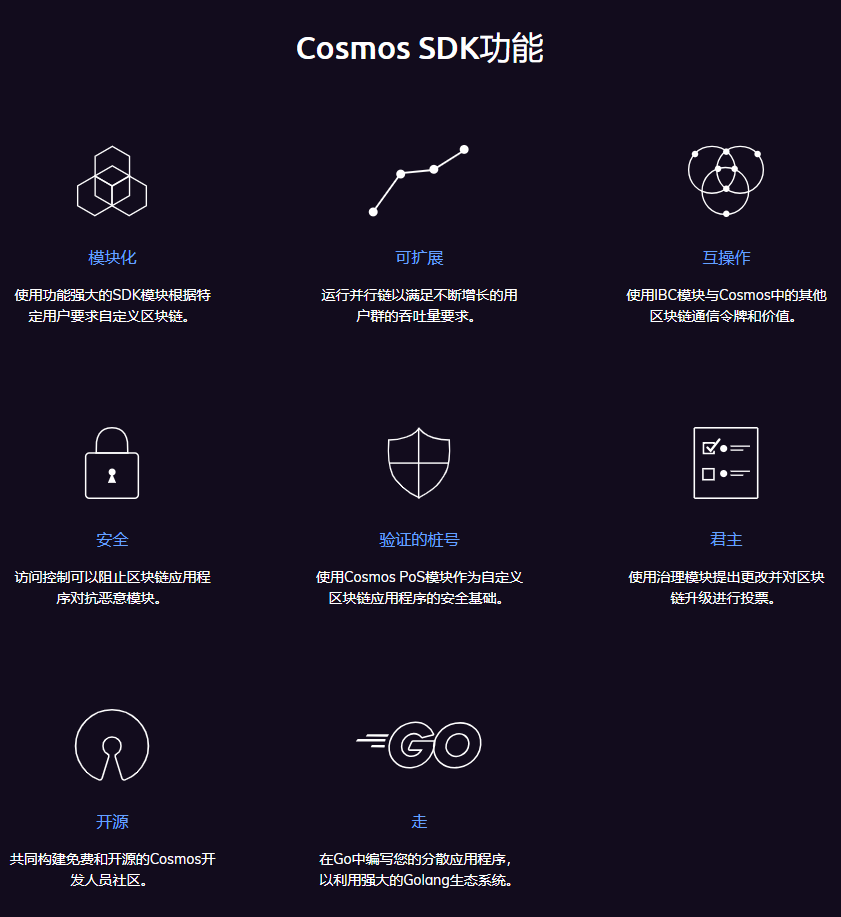-
Cryptocurrencies
-
Exchanges
-
Media
All languages
Cosmos is a parallel network with chains powered by consensus such as Tendermint. In the cosmos ecosystem, each space can communicate, trade and interoperate with each other. The vision of Cosmos is to break down the barriers between blockchains and create an internet of blockchains that will become the preferred platform for various practical usage scenarios.
This implementation is accompanied by the development of a series of system tools, including Tendermint, Cosmos SDK, IBC, and the communication between Hub and Zone is realized through the IBC protocol. The Go-Ethereum used by Ethereum is a monolithic technology stack category. Some upgrades to its features and enhancements in customization are the earliest entry point for Tendermint, which was established in 2014. Tendermint BFT is a solution that packages the network layer and consensus layer of the blockchain. Developers only need to focus on the application layer without caring about the underlying protocol. This developer-friendly design is seen in today's flood of public chains. It sounds nothing new, but if you consider that this idea first appeared at the end of 2014, you can naturally understand the forward-looking nature of cosmos.
Additionally, the main benefit of the Tendermint consensus algorithm is that it has a secure and simple light client, which makes it ideal for mobile and IoT use cases. The Tendermint light client only needs to be consistent with the validator group changes, and then validate the pre-committed +⅔ in the latest block to determine the latest situation. All in all, cross-chain is not the whole of comos. Tendermint technology has also made great efforts in saving development time. The attributes of Tendermint BFT are applicable to public chains and private chains. Tendermint BFT only deals with the blockchain network and consensus, node propagation Transactions and validators agree on a set of transactions to append to the blockchain, capable of processing thousands of transactions per second.
COSMOS is built on Tendermint's BPOS+PBFT consensus mechanism. The mechanism involves validators and proposers. PBFT is used to confirm the validity of the block, the number of pledged tokens determines the power of the verifier in the voting weight process, and BPOS is used to distribute the power of the verifier. The proposer of each round will be selected from the validator order list according to the proportion of their votes. Tendermint uses an optimal Byzantine Fault Tolerance algorithm selected by an absolute majority of two-thirds of the votes.
1. Cosmos SDK

. . . . . . . . . . . . . . . . . . .
On the basis of Tendermint BFT, the SDK further shortens the development cycle of third-party developers. First, it allows developers to port any existing blockchain code base on Golang, and Ethermint is oriented to the Ethereum network. All existing tools (Truffle, Metamask, etc.) are compatible with Ethermint, allowing smart contracts to be ported without additional work. The cosmos SDK is based on two main principles, and further standardizes the framework on this basis:
• Modularization: The Tendermint team built the basic modules required by the Cosmos Hub. Any developer can use these modules when building their own applications. And can create a module for Cosmos SDK.
• Security Boundaries: Limit the security boundaries between modules, enabling developers to better handle the composability of modules, and at the same time, limit malicious or scope for unexpected interactions.
Details of the Cosmos SDK can be found on the official website, providing libraries for building command-line interfaces (CLI), REST servers and various other commonly used utilities.
Second, IBC
In the cosmos network, the connection between blockchains is realized through the Inter-Block Communication Protocol (IBC) protocol. IBC utilizes the Tendermint consensus to allow heterogeneous chains to transfer values (ie tokens) or data to each other. Heterogeneous chains are characterized by having different layers, and each blockchain is maintained by a set of validators called miners. In their respective networks, the consensus and application layers are different. In order to be compatible with IBC, some consensus layer requirements need to be followed. IBC allows heterogeneous blockchains to pass tokens and data to each other, which means that blockchains with different applications and validator sets are interoperable.
When an account on chain A wants to send 10 tokens to chain B, the system will track continuously, allowing each chain to track the other chain's validator set. And each chain runs a light client of the other chain. When starting IBC transmission, the two key pieces of information in the IBC protocol are IBCBlockCommitTx and IBCPacketTx. The former records the latest block information of the sender; the latter is the information of the cross-chain transaction itself, which is stored by referring to the cross-chain command during execution. Outgoing queue; take out transaction information from the outgoing queue, submit it to the Hub, and the Hub will perform subsequent steps to realize cross-chain transactions. During this process, ATOMs are locked (bound) on chain A, and then the evidence of 10 ATOMs is forwarded from chain A to chain B, and the validity of chain A is verified on chain B. If valid, then Create 10 ATOM tokens on chain B. ATOMs created on chain B are not real ATOMs, a similar mechanism is used to unlock ATOMs when they return to their original chain.
Based on the design principle of IBC, each blockchain in the network can be connected in series with each other through direct connection. But this situation needs to face the uncontrollability of secondary growth. In order to solve this problem, Cosmos proposes a modular architecture with two types of blockchains in the network: hub Hub and regional Zone. The former is specifically designed to connect regions together. When a region establishes an IBC connection with a hub, it can automatically access (i.e. send and receive from) every other region it is connected to. Therefore, each region only needs to have a limited number of connections to a restricted set of hubs. Double spending within the zone is also prevented. The transfer of all tokens in the space will go through the Cosmos Hub. The Hub will complete the record of the total amount of tokens held in each space and the isolation of each space, including User Datagram Protocol (UDP) and Transmission Control Protocol (TCP). The status changes between the Hub and each space will maintain the consistency of information communication, and the Merkle-proof will be issued to indicate that the information has been transmitted or received.
Cosmos will provide good vertical scalability at launch, and after completing the IBC module, a horizontal scalability solution will be implemented. The first Hub launched in Cosmos Network is Cosmos Hub. Its token is called ATOM. Validators in Cosmos are similar to miners who provide machines, and non-validators delegate ATOM stake tokens for voting. In this way, a certain distribution of ATOM rewards is realized. When the verifier is attacked or does evil, the system adopts a certain mechanism to punish and weaken it.
3. Blockchain problems that Cosmos can solve
1. Scalability
Proof-of-work protocols are slow, expensive, not scalable, and environmentally harmful.
Tendermint BFT solves this problem.
Tendermint BFT is a Byzantine Fault Tolerant consensus engine that powers Cosmos Proof of Stake.
2. Ease of use
Blockchain applications are complex and difficult for developers to understand.
The Cosmos SDK fixes this issue.
The Cosmos SDK is a modular framework for building interoperable, application-specific blockchains.
3. Interoperability
The blockchain economy is isolated and helpless, and assets cannot be transferred between each other.
The IBC protocol solves this problem.
Inter-Blockchain Communication (IBC) is a blockchain messaging protocol similar to TCP/IP.
Fourth, main features and milestones
Tendermint Core: "Tendermint Core" is a ready-to-use blockchain engine powered by the Cosmos Practical Byzantine Fault Tolerant consensus protocol. The kernel can be used to build public or private blockchains. The consensus mechanism provides instant settlement and security; security is prioritized over network activity.
Cosmos SDK: As a convenient toolkit, the Cosmos SDK helps developers build application-specific blockchains.
Cross-chain communication: In order to provide developers with more tools for building blockchains, the next goal of the Cosmos project is to improve the interoperability between different blockchains and achieve cross-chain and cross-layer transactions. With the combination of partitions, users can freely trade within the token ecosystem composed of IBC compatible chains.
Related links:
https://cosmos.network/intro
https://www.dprating.com/rating/report/114
https:// cosmos.network/resources/whitepaper











